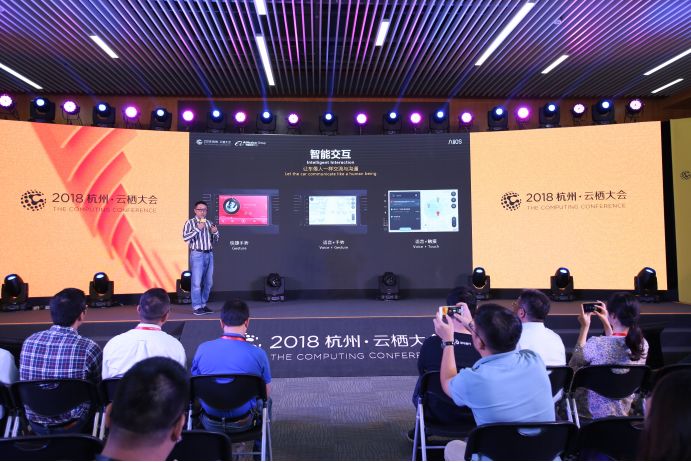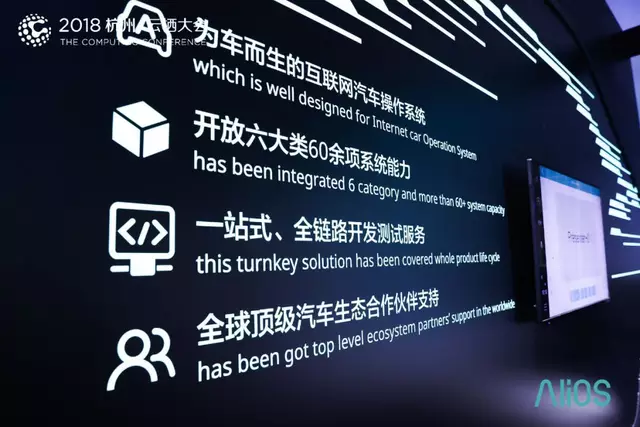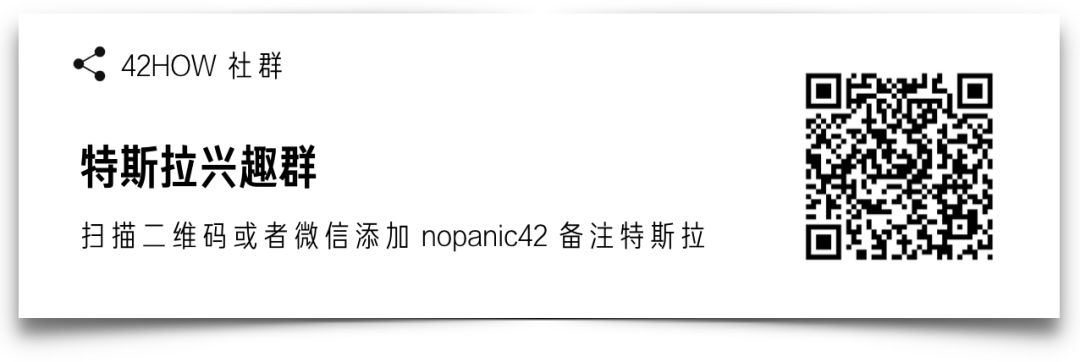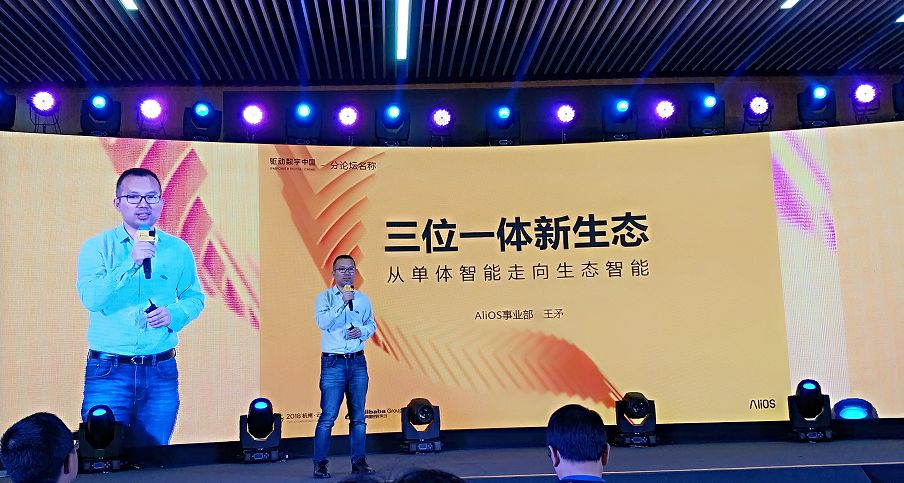On July 6th, 2016, SAIC Roewe announced their Roewe RX5 internet-enabled car at the Alibaba Cloud Computing Conference. This domestically-produced car with high-quality intelligent user experience has received excellent feedback in sales, and brought joint venture company Banma Network Technologies to the forefront.
As the underlying system that ensures basic user experience, Alibaba’s operating system, AliOS, is of great interest. At the recently concluded Alibaba Cloud Computing Conference, we interviewed Wang Mao, the general manager of Alibaba’s AliOS division and asked about AliOS’s vision, plans, and core competitiveness. The following is an edited transcript of the interview, Enjoy.
Question: How will AliOS expand?
Wang Mao: If we focus on the making of new cars like the Roewe RX5, it took us two years from 0 to 1. For the automotive industry, the scale of the operating system is very important. It is clear that one PC cannot do much, but a lot of PCs can be fun. Scale is our most important thing.
[Caption: Roewe RX5’s intelligent experience is well received.]
Specifically, our next step in accelerating is through the means of opening and being more dedicated to open source. We’ve done some open source work last year, and from a technology perspective, many of these are very critical. In the future, we will become more open source, allowing the industry to use OS, can access to the technology of OS, and use this technology further.
Question: You are addressing the challenge of 0 to 1, what about Banma?
Wang Mao: Quantifying the challenge of 0 to 1 is difficult, it is only a qualitative method. We are addressing the issue of possibility. Banma is addressing the issue of quality, such as the differentiation, competitiveness, and customization of its products.
Question: How do you solve the problem of low proportion of intelligent components in the current BOM cost structure of the whole vehicle?
Wang Mao: In terms of trend, the proportion of electronic components in the vehicle is increasing. However, this process of increasing the proportion is very painful, especially for automakers. Any increase in the price of each component, the proportion of each component, and the structural changes they bring, all cause a lot of pain for them. This is one aspect.## English Markdown Text
Secondly, using zebra will increase the cost to some extent, but we see that it has a great promotional effect on the sales of SAIC Internet cars. Because the user needs it. If prices are raised based on an unchanged product definition, this is not right. The core issue is whether the price increase matches its demand and whether new things are provided. But if I create a completely different user experience, it is different.
Thirdly, the cost evolution of vehicle intelligent parts is inherently fragmented. Today’s chips are still relatively small in terms of scale in the automotive field. The trend of the scale of hardware and the amortization of software costs is also conducive to market development in the future. It is just that today is still in the early stage.
**Fourthly, today’s software may define most of the car experience. But the price structure of automakers is that you buy it and it is sold according to hardware. However, the idea of the Internet is that I will pay if I feel good, and if not, I won’t use it. Or maybe the whole process is even free. So today, for the capabilities of a car and the software/service capabilities, it is still a transaction of material products. OTA is just a delivery. I made a new version and sent it to the user. OTA with 1.5 million people last year has become continuous delivery with endless iterations of software. *The way software is delivered has changed, so should the pricing method change? These have a great impact on costs.*
Question: If we observe the potential competitors in the entire industry, Android might be a possible one to make a breakthrough. Does AliOS have any differentiated advantages?
Wang Mao: As for Android, personally, technically speaking, it is no longer the focus of competition in the operating system field today. The core of our advantage lies in our closeness to the market.
China’s future young people are all natives of the Internet. Their expectations for cars are not just about driving and control. This group of users grew up with tablets and smart speakers, so their demand for the intelligence level of cars will become higher and higher.
The biggest advantage of AliOS is that we understand young Chinese Internet users better. For the Chinese automobile market, we can say that we can do what you want, which is our biggest feature. If everyone defines the future of cars as Internet cars, then looking back at the past Chinese Internet industry, the domestic companies have won over foreign ones. I still have a lot of confidence in this.
 When it comes to the challenges we face in the process of achieving this goal, there are indeed a lot of practical difficulties. However, we still believe that the big trend is that the internet industry is entering the automotive industry, and users have a demand for this. As a team with an internet gene, we definitely cater to user needs and iterate continuously. Looking at the automotive industry from a software perspective, we continuously deliver and iterate, defining value in the form of services.
When it comes to the challenges we face in the process of achieving this goal, there are indeed a lot of practical difficulties. However, we still believe that the big trend is that the internet industry is entering the automotive industry, and users have a demand for this. As a team with an internet gene, we definitely cater to user needs and iterate continuously. Looking at the automotive industry from a software perspective, we continuously deliver and iterate, defining value in the form of services.
Question: How does AliOS differentiate itself?
Wang Mao: The initial experience may be similar, but for example, the Roewe RX5 sold more than 200,000 units in just one year, while China sells more than 20 million new cars each year, and we account for only 1% of that proportion. In the past, the automotive industry’s structured definition of cars has been deeply rooted, but we and Zebra are deeply involved in the selection of cars at SAIC, and have a deep impact on various user experiences or conceptual aspects. We actually have a lot of ideas.
Today is a state of “big brain and small hat”. In order to achieve that kind of experience, we have developed an operating system, where the entire application architecture and information model have changed. When we started this project four years ago, it was completely different from Andorid. We considered the entire chain of data, lightweight services, maps as desktops, and voice interaction as the main focus. These four aspects were very advanced at that time.

However, limited by the structured thinking and inertia of the automotive industry, we only made a little progress in the car, and there were not many improvements released to the user experience in the end. But with just this little improvement, we have already received very good feedback.
Previously, Zebra conducted research and found that our young users like it very much. The high-end models of this car have a very high sales ratio (70%), and the daily active users are very high (99%), which means that all users will use this thing instead of buying it and leaving it there, still using their phones.
Therefore, on the one hand, we have been encouraged by this, and we are very serious about innovation in user experience and product innovation, which has received positive feedback from the market. On the other hand, we also believe that the competition in this market will be very fierce in the future, and I think that many car manufacturers will turn the definition of software, services, and data into the battlefield for the core user experience in the future automotive field.
AliOS has a lot of technology and business layouts, and is releasing them little by little.This is a state of high acceleration but relatively low absolute speed. However, this process will become faster and faster. AliOS has done a lot of layout in the past, including technological layout, many business and technical propositions. After the market becomes clearer, more differentiation will be released.
We have many ideas for user products, but are mainly limited by the car industry’s own cognition, cost structure, and the intensity of competition. Our trend is very clear, and we are confident that China’s car users can benefit from a combination of software, system capabilities like AliOS, and China’s Internet ecosystem.
Question: When AliOS supports implementing OTA for the whole vehicle, will car manufacturers who want to do whole vehicle OTA have reservations?
Wang Mao: There is a stand or product values behind AliOS, which is the fundamental part of common empowerment. I have often said in various occasions before that we need to solve the problem of whether it is possible, while the car factory and IT suppliers need to solve the problem of whether it is good or not.
The issue of whether it is possible is whether the system operates efficiently, whether the hardware starts up as expected, and whether the architecture design is structurally sound, so we are dealing with whether it is possible. The issue of whether it is good or not is controlled by the car factory and brand or the IT service provider. It is not up to us to handle every user experience of the product. Therefore, AliOS’s core task is to support the industry’s demands elastically and openly.
It is easy to develop solutions, but it is much more difficult to develop platform products. We are an operating system, a platform product, which is a big challenge for us. Our direction is different from that of solution providers and car manufacturers.
I hope that the media friends should understand this point that we are an OS, different from a solution provider who does end-to-end solutions, and different from car factories who self-develop platforms, or suppliers. We are an OS. We are in the middle, and we must leave a lot of differentiated abilities for the car factory, and the hardware selection issue is part of the differentiation. We must have this flexible space for them within the operating system.
If what we do ultimately reduces the OS to a definition of a physical button, it would be an insult to us and greatly reduce the sanctity of the operating system. Therefore, our team is completely different from the solution teams in the market, and the difficulty is also different.
Question: Compared with consumer electronics and smart homes, the development environment and test standards for vehicles are more stringent. How does AliOS solve this problem?“`
王矛: In the automotive field, if it is just the center console, the safety and redundancy requirements are not as high. However, if we enter into the fields of instrument clusters, body control, and driving control, the requirements for safety and redundancy are different. Therefore, AliOS has developed an operating system specifically for the automotive industry, adhering to industry standards and specifications.
This requirement is good for us in two ways. On the one hand, it requires us to comply with industry regulations. On the other hand, it will gradually become our advantage. Today, too many car manufacturers take some smartphone (Android) solutions and modify them, which is very unprofessional.
We are building from the bottom up, specifically for the automotive scenario. We attach great importance to this and we will always do it in this direction.
Question: The ratio and layout of buttons are different for every car model. How does AliOS consider this?
王矛: This is actually one of our abilities. In the past, our focus was on developing mobile operating systems. We probably have the most support for different hardware and software versions in China, more than any mobile phone manufacturer. AliOS has established an automation capability for version management, testing, and release. We are very confident.
Therefore, for us today, the different hardware, systemized testing, release processes, and version management for different sizes of vehicles are something we are good at, and this is one of our capabilities.
Regarding hardware, we mainly cooperate with ecological partners. For example, for a large touch screen, as long as you tell me the hardware specifications, my platform can manage the version control. I can do hardware testing and manage the whole process. If we don’t have this ability, we dare not talk about OTA. In the past, our scale of OTA in mobile phones was much larger than that for cars. And in the future, our engineering capabilities will be more than 20 million.
Question: What is the standard for our success in the automotive industry?
王矛: Quantitative data is a result-oriented indicator. Looking forward, it will depend on our technical leadership, the efficiency of empowering manufacturers, and the user experience of our products.


“`

This article is a translation by ChatGPT of a Chinese report from 42HOW. If you have any questions about it, please email bd@42how.com.
